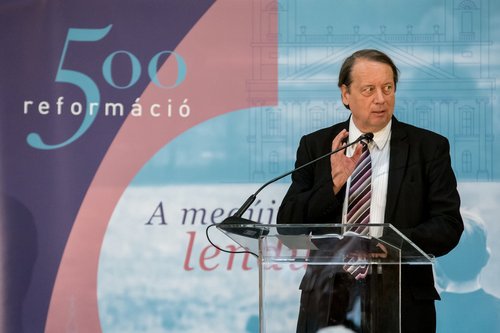The exhibition of the Hungarian National Museum titled „Ige-idők”, celebrating the anniversary of the Reformation, opened April 26th in Budapest. The exhibition gives us a thorough look at the past 500 years of Reformation, showing that the Reformation has not reached its end – it is an ongoing process, developing in our congregations.
“Our exhibition does not show only the great moments of Reformation, but it presents the structure of renewal of Reformed faith,” said Benedek Varga, Chief Executive Officer of Hungarian National Museum in his welcome speech. After the opening ceremony, our RCH team had the opportunity to take a look at the result of long months’ work: the exhibition - and the past 500 years as well.

We can ask the question whether it is possible to come up with new ideas in connection with the topic or not. However, the organizers of the exhibition managed to show the message of Reformation from a new angle, simply through its name. If written as one word, the Hungarian word “igeidők” would only refer to the trinity of past, present and future known from grammar. Since the word is written with a hyphen, it is obvious that we (also) refer to something else, something (also) in a figurative sense. We refer to Reformation, which connects the past (its history), the present (its ever-present and unavoidable achievements), and the future (its spirit and opportunities). The exhibition promises to display these steps, historical milestones, and the Hungarian Reformation – and the process by which they have become the part of our tradition. The jubilee exhibition IGE-IDŐK is realized in a broad co-operation and it is not only a historical event but also an occurrence which makes us aware that the gains of Reformation are an integral part of everybody’s life.
By Spirit
Presiding Bishop István Szabó, of the Reformed Church in Hungary, expressed his acknowledgement towards the initiators and organizers of the event. As he said, the goal of the exhibition is to make the values of Reformation visible in the 21th century. “Not by might, nor by power, but by my Spirit,” said Bishop Szabó, invoking powerful words from Zechariah. “If we understand the meaning of Reformation and Christianity we also understand the words of the prophet – it is not political conditions, power, or the enormous cultural achievement of humanity, but rather the grace of God, that keeps us here,” an idea which was often cited and emphasized by reformers. Bishop Szabó also reminded us not to forget those who are persecuted for their faith. He highlighted that it is not possible to organize a service of worship or speak about Jesus Christ freely in certain places of the globe – because imprisonment, persecution and death can be the consequences.
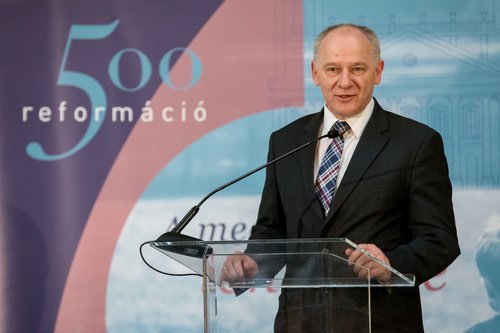
Presiding Bishop István Szabó, of the Reformed Church in Hungary, expressed his appreciation of the Hungarian government for the organization of the exhibition and for the setting up of the centennial committee of Reformation. He also showed respect for the Hungarian National Museum and for the work of its curators.
Bishop Szabó remembered the times of democratic transition, when Europe reunited in the hope of finding our European identity lost during the decades of communism. Now, we are still looking for that “profound, strong” and, in the good meaning, “radical” Christianity, which was the vision of the Reformation, by returning to the origins with the renewal of the external forms of Christianity.
“We should be grateful to God – because not political power, nor the enormous cultural achievement of humanity, but the grace of God helps us. After 1517 didn’t only come 1525, but 1526 [a significant year when the Ottomans defeated Hungarian forces at the Battle of Mohách, though the official occupation began in 1541 and lasted until 1699] and 150 years of Turkish occupation. A Turkish camp may have been even here, in the place of the museum. When arguing about immigration and Islam, I sincerely ask our German friends to consider this short 150 years of Hungarian experience,” said István Szabó.
The bishop called us to remember in our prayers those Christians who are persecuted throughout the globe. Here in Europe, we easily speak about oppression, dictatorship, liberalism and illiberality, whilst measuring our liberty on pharmacy scales and if a thousandth of a milligram is missing, we desperately declare war against each other. On the other side of the world it is not suggested to keep a service of worship, mention the name of Jesus Christ or simply to be Christian. In this case, the media’s disdain is not the only consequence - but deprivation of rights, persecution and death. Our gratitude to liberty cannot be emphasized better than remembering in our prayers the persecuted people. In 1541, during the Turkish occupation of Buda, Luther wrote his well-known hymn which both the Reformed and Evangelical congregations sing even today: “Lord, keep us in Thy Word and work…”
Common Origins
The first room of the exhibition evokes a 16th century atmosphere with paintings and short texts presenting the characteristics of catholic liturgy which was dominant in the era. Latin citations and labels make us feel how incomprehensible worships would have been and how quickly they alienated the Scripture from believers.
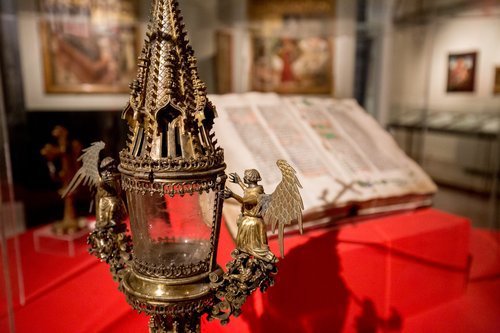
At the same time, we have to mention that our Protestant history didn’t start in October 1517, but 2000 years ago - at the empty grave. The necessity of Reformation was obvious, but we shouldn’t forget our Christian past and origin are common.
Although Reformation was inspired by the idea of “returning to the origins,” this was the source of renewal, too. The exhibition proves that Reformation is a religious process by which not only Christianity, but our culture itself, was reformed and opened up to the world.
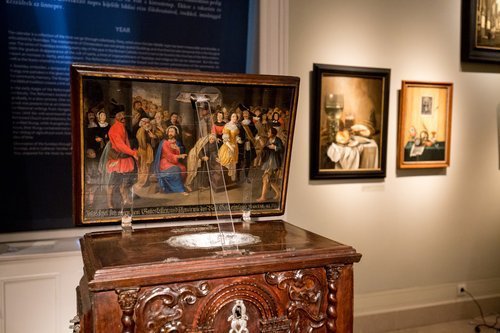
Alone
Entering the next room, we can get closer to Martin Luther’s and John Calvin’s activities, from the evolution of printing to the development process of Bible translation. We can observe human development perfectly through Bible-translations - started in the era in which only a privileged few understood it, today it is considered evident that we can read the Scripture in our mother tongues.

The well-known principle of “sola fide; sola gratia” is a fundamental tenet of the Reformed church. However, these were not “discovered” by reformers - they simply returned to them.
This is the room where the meaning of the name of the exhibition really takes effect. Due to the press, emphasis has been put on the text of the Bible and on the word of God, and not on practices. This reshaped both our traditions and our view of time.
Péter Gáncs, Presiding Bishop of the Evangelical-Lutheran Church in Hungary, stated that the name “Ige-idők” for him means the words of God reaching us in given periods of time and dates - such as October 31st, 1517. He expressed his expectations that 2017 is going to be a year of such a great event. “Though you have made me see troubles, many and bitter, you will restore my life again; from the depths of the earth you will again bring me up,” said Péter Gáncs, citing Psalm 71:20. He then explained that although this sentence contains all the pains and challenges of the past, it is not a lament, but a confession. “Reformation is not still water, but a spring to which we can always return. We hope the exhibition will move all of us towards mapping our common origin and identity we received from God,” added Péter Gáncs.
Through Time and Space
The exhibition presents the last 500 years of Hungarian history – which was heavily influenced by the Reformation – and Hungarian Protestants at the same time. Through getting to know the Reformed and Evangelical liturgical milieu, we have the opportunity to get an insight into the lives of great rulers of Transylvania – such as István Bocskai, Gábor Bethlen and György Rákóczi I. – who were advocates for defending tenets of Reformation and freedom of religion.
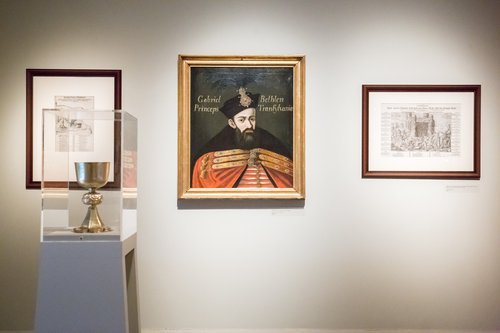
The bulk of the exhibits were unknown so far – most of them arrived from congregations and from collections in Debrecen, Pápa, Sárospatak, Kecskemét and Budapest. The rest of the pieces are borrowed from the National Széchényi Library, the Library of the Hungarian Academy of Sciences, the Hungarian National Gallery, and the Museum of Fine Arts. The organizers also stressed the importance of our history in the Carpathian Basin, looking for pieces over the border. With the help of the exhibition, we can indeed get a broad outlook on the Reformation process, and it also reveals that we should not just remember a single moment of 1517, but the whole journey itself.
Ties us Together
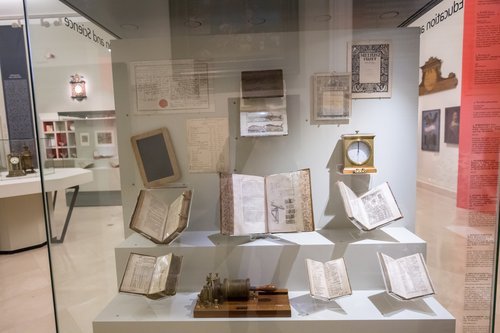
It is of special importance that the works of recognized artists, politicians, writers and poets of the Reformed ideology are displayed at the exhibition, too. Their activity had a profound impact on Hungarian culture and they could mean a lot to those for whom the Reformation itself didn’t. We can find the Bible of Sándor Reményik, a sculpture from the legacy of Mihály Babits, a chalice gifted by Endre Ady, and a lot more specialties in one group with Gál Huszár’s hymn-book and seventeenth-century political pamphlets. All of these are the intellectual and material relics of the last 500 years.
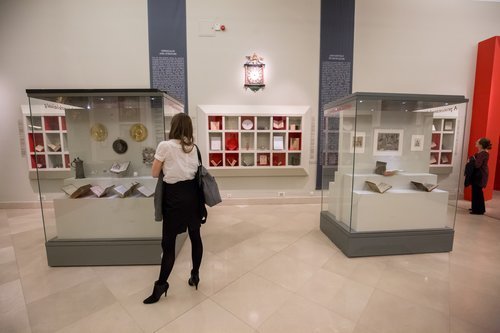
Living Church
The exhibition is able to come up with novelties in connection with our last 500 years of Christian past by not only presenting historical events and biographies, but clarifying the process and ties between them. Visiting the exhibition we can gain a unique experience either ecclesiastically or aesthetically. At the end of it, we can have a look at the activities of Reformed and Evangelical congregations of cities and villages with the help of an interactive map. This map proves that the Reformation has not reached its end – it is an ongoing process, developing in our congregations.
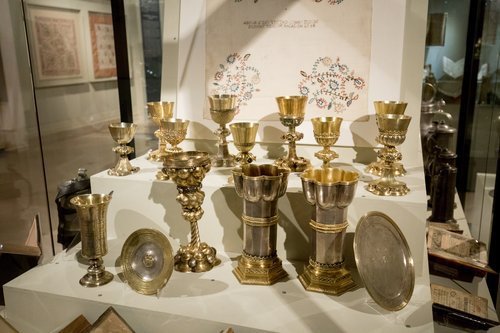
“Ige-idők – 500 years of Reformation” can be visited between April 27th, 2017 and November 5th, 2017 at the Hungarian National Museum in Budapest.
Translated by Gréta Pataki
Via:
reformacio.ma
reformacio2017.hu
parokia.hu
